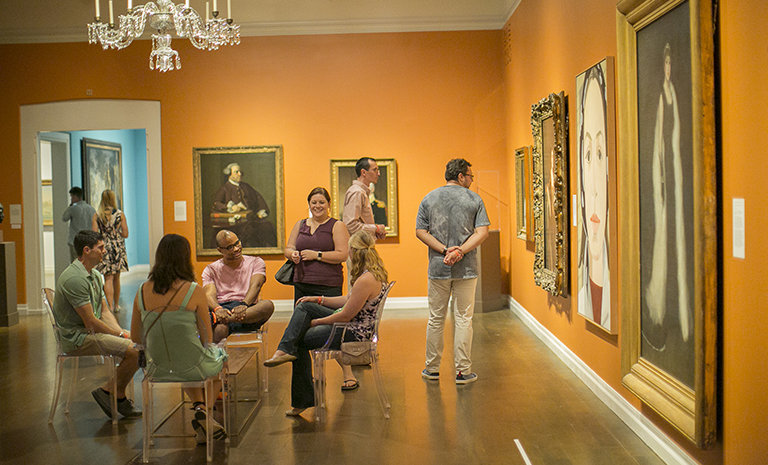Arts and Culture
Audience Development
Business Strategy
Customer Service
Marketing
Article
Insights & Innovation
7d320bd7-c4e2-42d8-8056-2966eb62b89e
7 min
https://edge.sitecorecloud.io/tessituraneab9a-tessiturane5642-staging-5396/media/Images/Licensee-Photography/Photos_768x465/jazz_lincoln_768x465.jpg?h=465&iar=0&w=768
Four keys to cultivating better customer relationships
Know your visitors
9/30/2022
7 min
If you want to keep and grow your audiences, you must invest in understanding them better.
But what does it mean to know your visitors?
The following stories illustrate four keys to cultivating better customer relationships. They prove there’s power in digging deeper into details. They show the value of communicating with patrons on a personal level and meeting them where they are. These organizations acknowledge the unique paths that bring people through their doors — and back again.
The connections you make with audiences or visitors depend on an infinite combination of touchpoints.
1. Understand there’s no single journey
Think about your relationships with your favorite arts and culture organizations. Did you buy a ticket to a dance performance after attending a community class? Did you become a member to introduce your children to a museum or zoo you first visited on a school field trip? Maybe you added a donation to your annual theatre or symphony subscription to get access to behind-the-scenes events.
There is rarely one way people discover your programs. The connections you make with audiences or visitors depend on an infinite combination of touchpoints. Together, they tell their unique story or customer journey.
Understanding and influencing those journeys requires a proactive and ongoing strategy. You must aim both to capture and to analyze all important visitor interactions.
“You don’t realize what that 360-degree view of a patron’s going to do for you,” said Jen Skelly, Point-of-Sale Administrator and Business Analyst for the Canadian Museum for Human Rights in Winnipeg, Manitoba. “To be able to know how that person interacts with your organization everywhere. Not just are they coming through your doors, but are they giving? How often are they coming through your doors? Is there a specific time? All those things can be analyzed, and it turns into money.”
To make connections across your organization, you also need technology that allows you to track and view engagement in one place.
“Having one system as a source of truth has been transformational for our business,” said Jaime Lemus, Chief Information Officer at the California Academy of Sciences in San Francisco, which adopted Tessitura in 2019. “When we have a single system, a CRM that houses all the information about our constituents, what we have is the potential for robust insight into our customer journey. It’s one we never had before when we were looking at multiple systems.”
Individuals view their associations with your organization holistically. They want your organization to view them that way, too.
2. Appreciate the bigger picture
Depending on the role you hold in your institution, you might think of a particular visitor as a ticket buyer, member or donor. But it’s important to remember they rarely think of themselves in similar siloed ways. A donor may also be a student in your education programs. A member may volunteer.
Individuals view their associations with your organization holistically. They want your organization to view them that way, too. That requires mapping their behaviors over time.
Mary French is the Associate Director of Data Services for Ohio’s Cincinnati Ballet. She knows there’s long-term value in tracking a fan’s evolving interests with her company.
“We have classes for people from 2 to 200. Whether you want to be a professional ballerina or you just love to dance, you can do that,” Mary said. “And it means a kid may be in our program all through high school. They go off to college. They become some amazing professional. When they come back, we can say, ‘Oh, do you remember way back when you were in that spring production? Why don't you talk about that and why you're now our donor?’”
“So much of marketing now is about audience development and about going beyond transactional relationships into true relationships with your audience.”
3. Make it personal
Your visitors don’t only travel different journeys. They also exist at diverse points on those journeys. Segmenting for those differences allows you to communicate in ways that resonate.
“It’s important to know, when we’re talking to our community, what they’re interested in hearing about and what they’re not interested in hearing about so that we’re delivering relevant messages and products to as many people as possible in our region,” said Anh Le, Director of Marketing and PR for Opera Theatre of St. Louis in Missouri.
It means recognizing the next right step for each individual. Gabe Johnson, Director of Sales and Analytics at New York City’s Roundabout Theatre Company, thinks it’s like dating.
“I want you to feel like we’re creating a sincere relationship with you, so I’m going to need to get to know you a little more through your behaviors, your interactions with what we send you, before I can move to the next step,” Gabe said. “When we’re ready to move to the next step, then we can see how you feel about that. Are you going to become a subscriber? Are you going to become a donor? Are you a champion for Roundabout?”
Opera Theatre of St. Louis takes a similar approach. “So much of marketing now is about audience development and about going beyond transactional relationships into true relationships with your audience,” Anh said. “Tessitura is helping us achieve that because we can slowly move people along a roadmap for customer engagement that gets them to a sense of true ownership and belonging in our organization.”
Arts and culture professionals keep meeting their communities where they are, even when that feels like a moving target.
4. Meet people where they are
There’s no question the world we live in now is different from two years ago. The pandemic changed longstanding audience patterns and expectations about entertainment experiences. Arts and culture professionals keep meeting their communities where they are, even when that feels like a moving target.
“Patrons are different. They’re experiencing the world differently; they’re experiencing people differently,” said Tess Todora, Director of Ticketing and Patron Services at Austin Theatre Alliance in Texas. “In some ways, we are forever changed. We have to take into account people’s comfort and their needs and wants in a way that we hadn’t before. I also think we’ve had to be more vulnerable, more compassionate, more honest to give people the arts and culture experience they want and need.
“We know that things can change on a dime,” Tess continued. “We’ve had to throw out ‘This is what we’ve always done.’ That no longer makes sense. That no longer cuts it. But I think it helps us do a better job and serve our community better.”
• • •
Tessitura provides tools to create seamless customer journeys that build lifelong relationships. Manage ticket sales, memberships and donations alongside customers’ preferences in one solution. To learn more, explore Tessitura’s unified CRM features.
Topics
Arts & Culture
/Audience Development
/Business Strategy
/Customer Service
/Marketing

Propelling innovation
Arts & Culture / BI & Analytics / Business Strategy / Digital / Technology
Three technology advances driving digital transformation in arts and culture

Debunking four digital transformation myths
Arts & Culture / BI & Analytics / Business Strategy / Digital / Technology
Setting the record straight about common misconceptions

